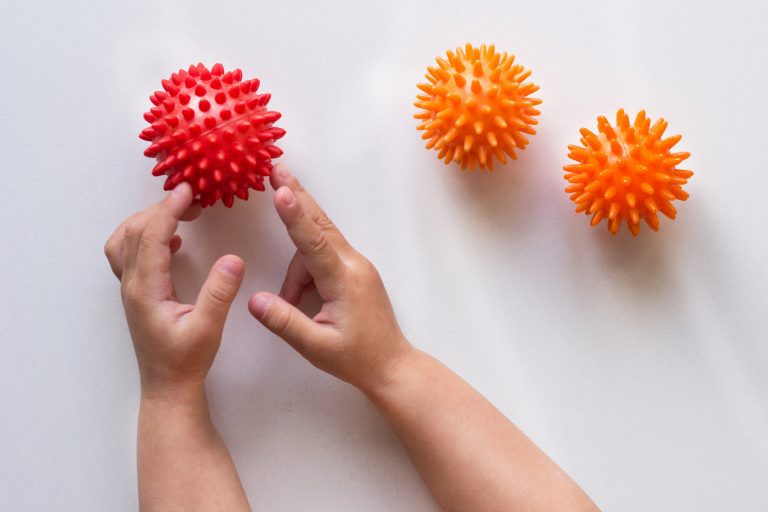Children instinctively use their senses to explore their world.
Sensory play is becoming very popular and with reason. It is now part of our everyday life. When we got pregnant, I had no idea how it would play a vital role in our daughter’s development. Nor did I expect all the challenges that would be presented to us along the way.
It all started with Autism
I’ll remember that day forever. It was November 21, 2019 – a cold rainy day. We were sitting in the pediatrician’s office, sharing multiple reports we had received from our speech therapist, our occupational therapist and our daycare. They were all pointing to mild-to-severe delays as well as high sensory sensitivities. After discussing many of our concerns, she could deliver her diagnosis. Without a doubt, our daughter was indeed on the autism spectrum. It was now official.
Even if I had a strong suspicion for months, it still hit me like a ton of bricks. I remember how the whole room stopped moving and I could only hear half of what she was telling us. It hit hard for both of us. We cried all the way home. We felt so lost and overwhelmed by everything. We felt scared by the unknowns of her future. I remember feeling like “Ok, where do we go from here?”.
Why I suspected Autism early on
My concerns started around 13 months when I noticed that my daughter wasn’t smiling on pictures. She would often wake up at night and I couldn’t cuddle her back to sleep. The only way to calm her down was 10 minutes of cartoons. I would put her back to bed and cry myself to sleep, wondering why I couldn’t comfort my own child.
Developmental milestone delays were also signs. She was babbling and was saying “ma-ma” by 14 months. Then she regressed at 18 months and never said mama again. That’s when I knew I had to act on my instincts. She had just started walking at 18 months. Delayed walking is another very common sign.
She had high sensory sensitivities to sounds, sunlight, and movements. She hated any activities or toys that was unstable like ride-on toys. She was also showing delays in her gross motor skills. When she was a newborn I was told that I had a high needs baby. She needed to be held a lot and would cry often. Looking back, we had many signs from a very young age.
It has now been well over a year and I can tell you this. We have been blessed with such a happy little girl who lights up our world. I still have fears, I still worry, I still think “Where do we go from here?” If you are going through this, I want you to know what you are feeling is normal. You are normal. I’m assuming I will feel this way forever, for different reasons, as it evolves. I also want to tell you that Autism has also been a blessing.
We have learned so much about her, about us. We now have a deeper compassion for all families on a similar journey. It opened our hearts to feelings we never knew we could feel. Best of all, it reminded us to remain in the present moment. I’ll be honest it was hard for me to process all the feelings I felt. I cried every day for almost 2 months after her diagnosis. I was nearing an emotional burnout.
By chance or faith, I was inspired to create an outlet for my feelings, to focus on the good and not just on our challenges. In January 2020, I launched a Facebook page called Fun Sensory Play and I call it my saving grace. It saved me in ways I never imagined and it has helped others more than I ever thought it would.
Why is play important for kids on the Autism spectrum?
Our family became very focused on play. I discovered through various therapies, books and education that PLAY is the best tool for kids on the spectrum. I like to say that play is the way to your child’s heart. Through play they can engage and interact with the world around them. This is so important for kids on the spectrum as it is a common challenge. Once you have their attention, it creates a connection which makes it much easier to teach your child. Playing doesn’t feel like “work” – playing is fun and that’s how kids learn best.
We do our best to bring play in every activity and daily routines, as we now understand how beneficial it is for our daughter’s development. When I’m in a rush to get out the door, I’ll admit that play is the last thing on my mind. I had to train myself to take life a little less seriously and be in the present moment with my daughter. That’s another reason why autism is a blessing. We are more connected to her and to each other as a family.
How Sensory Play helped our daughter
Our natural reaction was to avoid all situations that made her cry, scream or afraid.
We didn’t know that avoiding what would create a sensory reaction (meltdowns, hysteria, crying etc.) was the wrong thing to do. It is human nature to protect your child from anything that may hurt or cause them any kind of pain. But we weren’t doing her a favor by doing so.
With sensory sensitivities, we learned that you have to slowly desensitize them to the feeling or sensation they dislike. So for my daughter, we had to keep initiating sensory play with play dough even if she resisted the sensation. She would ask us to play with it, mold it for her but she would rarely touch it. Sometimes she would poke it, but nothing more. Today, she squeezes the play dough. She loves it and I’m so proud to see her enjoying this activity. Here’s a taste-safe play dough you can make at home.
She was also sensitive to the texture of sand. Again, we repeatedly provided opportunities for her to explore the experience and sensations. We tested various textures and found that she really enjoyed to play with oats. I created simple sensory bins with oats with little scoops and cups. All toddlers love to pour and dump!
I then tried a taste-safe sand made with crushed cheerios and it was a total hit! She loved it. Find the instructions to make it here Edible Play Sand. It wasn’t the full texture of sand but it was similar. We were on our way! As you may see, we were presenting incremental activities that would lead her to enjoy the feeling of sand. Fast forward to today, she now enjoys playing with sand. Success!
If your child is struggling with various sensory sensitivities, the key is to repeat the activity in hopes that your child will adjust to the sensation. We were also struggling with the idea of “messy”. Through this journey, we’ve learned to accept the mess and jump in to play. Sensory play is good for grown-ups too!
Sensory play is a true gift to any child’s development, and I encourage you to provide them with as many experiences as you can. It can also be very calming for kids, as it helps them regulate any discomforts they may be feeling. It’s been a blessing to see our daughter bloom through all the sensory experiences. I hope it can do the same for your child.

About the Author:
Chantal is the founder of the blog Fun Sensory Play which was inspired by her daughter’s journey with Autism. Through her blog and online presence, she hopes to inspire more families to play.

